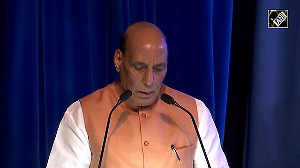The days of broad-based rallies are long over. With the markets going through a volatile phase - though it did start Samvat 2062 on a bright note - it is becoming imperative that investors keep a close watch on their portfolios.
While analysts and fund managers insists that there is still a lot of value lying unlocked in many counters, picking the right stock is as tough as finding a needle in a haystack.
Opinion of market experts vary. One school of thought suggests that the correction in large caps has made them attractive again, while another opinion doing the rounds is that several mid caps which has seen a big correction in the recent past offer good value for money, given their strong fundamentals.
Given the scenario, where does an investor park his money? Should one hold on to the stocks whose fundamentals are looking sound, despite a correction in stock price? Or should investors book profits in those counters, which went down at an alarming rate and look for opportunities somewhere else?
The big fall
To get a better perspective, the Sensex after climbing to its all-time high of 8799.96 on October 4, 2005 shed 1114.32 points to 7685.64 on October 28, 2005.
However, things improved last week as the markets embraced the Diwali spirit with a 387.11 points rise in the Sensex in the past three trading sessions. Though the rise cheered sentiments to an extent, concerns remain.
The Sensex is down 6.51 per cent in the past month, while the losses in the mid cap and small cap segment are even more. The BSE Mid Cap index is down - 8.66 per cent for the period, while the BSE Small Cap index has lost 10.90 per cent.
Statistics apart, does the correction point to a larger malaise lurking underneath? The answer is a resounding no. That is, if you want to believe market analysts and fund managers.
Most agree that the correction was bound to happen some time or the other, considering the rather unchecked rise in stocks in the past year. Only, the swiftness of it has caught many off guard.
Stocks across market segments have witnessed a correction, irrespective of whether they are large caps or mid caps. Out of the 30 Sensex stocks, only Satyam has managed to post gains during the one - month period ending November 4, 2005.
Pharma major Ranbaxy suffered the worst losses (down 30.03 per cent at Rs 351.65). Metal stocks, Hindalco (down 20.95 per cent at Rs 120.70), Tata Steel (down 19.73 per cent at Rs 347.70) and auto major Tata Motors (down 15.56 per cent at Rs 480.65) were the other big losers.
All part of the game
"There is nothing wrong with the kind of correction that we witnessed recently. It is just that the markets rose too fast and it is only natural that the correction would be equally sharp," says Manish Shah, head of retail products & strategy at domestic broking firm, Motilal Oswal Securities.
"I would expect the correction to last longer time-wise than price-wise. From now onwards we are likely to witness more of sideways movement rather than any dramatic rise or fall," he adds.
According to Mihir Vora, vice president, head of equities at ABN Amro Mutual Fund, markets are in a consolidation mode.
"We have seen robust inflows from offshore funds in the past year. So it is but natural that they would book profits to meet their year-end targets. Despite the current correction, I believe that there is a change in the perception of India as an attractive market to invest in. Over a three to five year time frame, I would expect the markets to give a return in the range of 12 17 per cent," he adds.
Sandeep Neema, fund manager at JM Financial Mutual Fund is also of the opinion that the markets may be witnessing the last legs of the correction. "I think the major correction is over," says he.
"I expect a period of consolidation in the markets, before the next upmove. Historically, bull markets have witnessed correction and this one is no different. I don't think there is any change in the fundamental story."
Though the market participants are bullish, they do throw in the customary word of caution. The idea they say is to stay invested in the long-term and forget about short-term corrections. If you don't have the nerve to wait that long, then avoid small-cap and risky mid-cap counters.
Large caps, which have seen a correction and thus have attractive valuations with strong fundamentals might present a better investment opportunity. And even if the markets fall they will protect you against big downsides.
Valuations are still attractive
Analysts agree that despite the volatility in the markets, valuations continue to be attractive. The Sensex is currently going a P/E of 15x, which is considered attractive. Mid cap valuations have also corrected themselves after the downsides in the past month and have come down to 16x, from the 18-19 levels not so long back.
Says, Sashi Krishnan, chief executive of Cholamandalam Mutual Fund, "we are not too worried about the current volatility, since we always advise people to invest for the long-term. Corporate earnings growth has been on track and I don't think there is any major cause for concern on that front. We remain bullish on the long-term outlook.
"While most are bullish on the long-term, people like Shah see value even if markets go down in the short-term.
"The markets will provide great value buying opportunity if the Sensex goes below 7,500 levels," he says. So is it time for bottom fishing? "In a way, we are happy that markets are going down, because it presents us with a buying opportunity, though I wouldn't call it bottom fishing" says Tejas Doshi, head of research at Sushil Finance Consultants. "We do advise our clients to buy on dips at counters that we are bullish on," he adds.
According to Shah, there is still a lot of value buying opportunities in the market. "In this market, it is very important to pick and choose stocks that you want to invest in. Whenever, there is a profit booking opportunity one should also try and do that. It all depends on what levels one bought the stock." But going in for profit booking at this stage does not make much sense, say experts.
"I don't believe that it makes much sense to book profits at fundamentally good counters at this point, since most stocks have already witnessed a big correction. It is better to pick stocks that have seen a correction in price, where fundamentals are in place and valuations are looking attractive," says Neema.
Go for large-caps
As a strategy, market experts advise to look for large-caps. There is a sound reasoning behind that line of thinking. "In the aftermath of the current correction, it will take a long time for small-caps to recover," says Neema. He notes that while small-caps have the potential to provide higher returns than other segments, they carry a higher risk too, which makes them avoidable in this market.
"When the markets recover, large-caps and mid-caps will recover faster than small-caps. So as far segment-wise allocation is concerned, my advice would be to go for large-caps and mid-caps that offer value propositions," says Neema. Shah notes that there are good stocks, which offer value for money in the mid-cap segment too.
"But one has to keep a good margin of safety in these stocks. One should keep enough leeway for bad news in these markets. Dividend yield stocks would be good idea to invest in currently," says he. Shah has his own favourites in the large-caps as well.
"Among large-caps I am bullish on Bharti Tele, Hero Honda and Bajaj Auto. I expect two-wheeler stocks to do better than commercial vehicle makers or car makers. Apart from telecom and two-wheelers, I am also bullish on the banking sector." On the other hand, Shah is bearish on stocks in the media and IT software sector, which he believes are over valued at this point in time.
According to Vora, Infrastructure segment and related sectors like capital goods, engineering and construction etc., apart from auto and banking and finance segment look good. Like Shah, he is also bearish on software services segment apart from oil & gas sector.
Doshi notes that there are a slew of stocks in both large and mid-cap segments, which are looking positive.
"Among frontline stocks, we like Infosys, SBI, Hindalco and Ashok Leyland. We believe that there are lots of buying opportunity in the mid-cap segment as well. Some of the stock that we are bullish on are, corporation Bank, UTI Bank and Karnataka Bank from the banking sector, Munjal Auto, SKF Bearings and Ahmednagar Forgings from the auto ancillary segment, Elecon Engineering, Honeywell Automation from the engineering sector and Solvay Pharma on the pharmaceutical front," says he.
According to a fund manager at a leading domestic mutual fund, it is difficult to make a call in favour of or against large caps and mid caps in this market.
"The gap between large caps and mid caps has shrunk. Thus it is important that investors choose companies that have a quality business model, good management team and earnings visibility," says he. According to him in a stock picker's market such as this investors need to pay a premium for high quality companies.
While professionals vary in their assessment of sectors and stocks, most agree that it is fundamentally a stock pickers' market, where every step has to be taken with utmost caution. Shah puts it nicely "In a nutshell, I don't think this is an ideal market where one should try to be brave. My advice would be to exercise caution in your investments."






 © 2025
© 2025